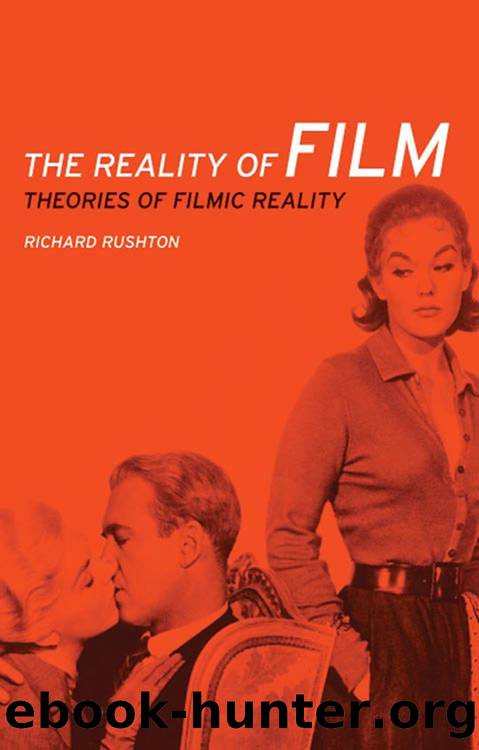The Reality of Film by Richard Rushton;

Author:Richard Rushton;
Language: eng
Format: epub
Publisher: Manchester University Press
Published: 2011-02-14T16:00:00+00:00
Subjectivity
That is the reality of film for Cavell. The experience of sitting in front of a movie screen and seeing the stairwell distort in Vertigo is a real experience. It is not a real ism, for how could one prove or even claim that the effect of the distorted stairwell is an accurate reproduction of what one would see in the real world? And yet, all the same, it happens there in front of me on film when I watch Vertigo as a reality of the experience of watching that film (as something, in other words, that really does happen). It might be understandable, given his faith in photographyâs ability to capture reality and of the correlative ability of the world to exhibit itself on film, that Cavell has often been thought of as a realist. He goes to great pains to try to clarify his perspective on photography, but even then Cavellâs thoughts are not entirely clear. Perhaps this is merely an outcome of what Roland Barthes referred to as the âphotographic paradoxâ: that when we see a photograph of a thing, we see, at one and the same time, the photograph and the thing itself (Barthes 1977a). This is a far more difficult argument to accept than the one, even more common now than it was when Cavell was writing The World Viewed, that argues that the camera lies or that âthere is no way in which a photograph really represents a real objectâ. The logic of this kind of argument is one that stresses the ways in which a photograph can never be the same as reality or never really capture the realness of the real; in other words, photographs will always be removed from reality or a distortion of reality. Such arguments insist on the sanctity of a reality that is entirely separate from a photograph, which is to say that they insist upon the separation between the realm of representation and that of reality. To put it simply, this is an attitude we have come across again and again in this book: that films, as much as photographs, are âonly representationsâ; they are illusions entirely distinct from the reality of a real that is âout thereâ. Cavellâs view is both more straightforward and more difficult than such a dismissal: that in a photograph reality and representation are conjoined.
This photographic paradox does not mean that in a photograph we cannot distinguish between reality and its representation, it merely means that if we conceive of a photograph as a representation then that representation carries with it something of reality. Cavell is more or less content to call this a photographâs mystery; we cannot somehow explain away the mystery whereby a photograph of Napoleonâs nephew ineluctably shows us âthe eyes that looked at the Emperorâ (as Barthes so astonishingly puts it; 1981: 3). Cavell argues that âthe relation between photograph and subject does not fit our conception of representation, one thing standing for another, disconnected thing, or one forming a likeness of anotherâ.
Download
This site does not store any files on its server. We only index and link to content provided by other sites. Please contact the content providers to delete copyright contents if any and email us, we'll remove relevant links or contents immediately.
| Coloring Books for Grown-Ups | Humor |
| Movies | Performing Arts |
| Pop Culture | Puzzles & Games |
| Radio | Sheet Music & Scores |
| Television | Trivia & Fun Facts |
The Kite Runner by Khaled Hosseini(4975)
Gerald's Game by Stephen King(4391)
Dialogue by Robert McKee(4184)
The Perils of Being Moderately Famous by Soha Ali Khan(4076)
Story: Substance, Structure, Style and the Principles of Screenwriting by Robert McKee(3339)
The 101 Dalmatians by Dodie Smith(3331)
The Pixar Touch by David A. Price(3233)
Confessions of a Video Vixen by Karrine Steffans(3118)
How Music Works by David Byrne(2976)
Fantastic Beasts: The Crimes of Grindelwald by J. K. Rowling(2860)
Harry Potter 4 - Harry Potter and The Goblet of Fire by J.K.Rowling(2831)
Slugfest by Reed Tucker(2820)
The Mental Game of Writing: How to Overcome Obstacles, Stay Creative and Productive, and Free Your Mind for Success by James Scott Bell(2776)
4 - Harry Potter and the Goblet of Fire by J.K. Rowling(2551)
Screenplay: The Foundations of Screenwriting by Syd Field(2451)
Scandals of Classic Hollywood: Sex, Deviance, and Drama from the Golden Age of American Cinema by Anne Helen Petersen(2409)
Wildflower by Drew Barrymore(2389)
The Complete H. P. Lovecraft Reader by H.P. Lovecraft(2380)
Casting Might-Have-Beens: A Film by Film Directory of Actors Considered for Roles Given to Others by Mell Eila(2312)
